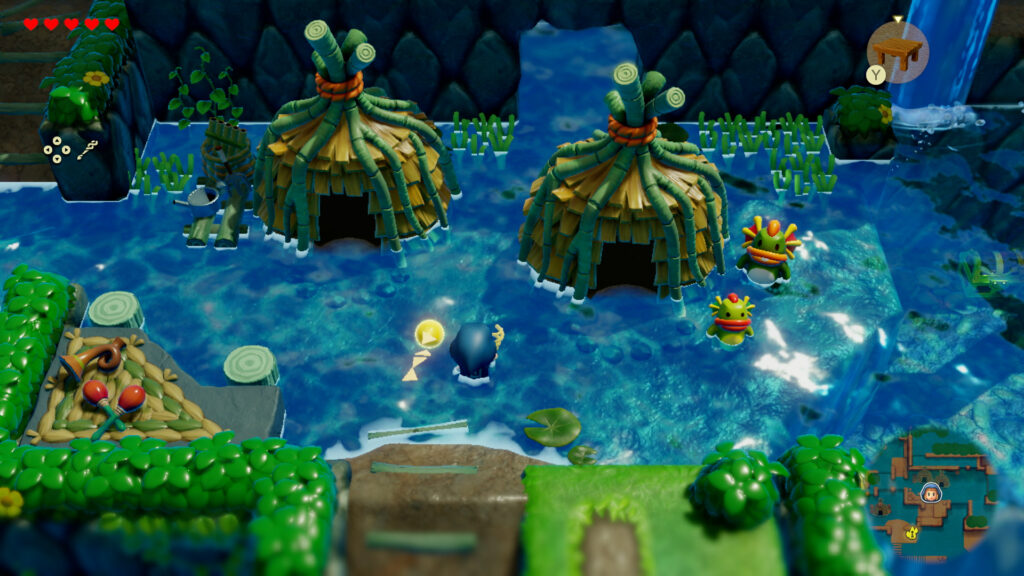Available on: Switch
Played on: Switch
If there’s one game publisher that never forgets its roots, it’s Nintendo. While The Legend of Zelda: Breath of the Wild and Tears of the Kingdom expertly expanded 3D open-world gameplay on the relatively tiny Switch hardware, The Legend of Zelda: Echoes of Wisdom is a return to classic top-down adventure, with a fun game-changing twist and modern sensibilities that feel both nostalgic, and refreshing.
Read on for our review of The Legend of Zelda: Echoes of Wisdom!
Echoes of the Past
Echoes of Wisdom’s first major twist is that it actually stars Princess Zelda as the playable protagonist (somehow a series first). After rescuing her in the prologue (naturally), Link succumbs to the strange rifts that have begun spreading all over Hyrule, plunging people into a dark mirror dimension known as the Still World.
When people become trapped inside the Still World, they’re replaced by shadowy doppelgangers bent on sowing division — including blaming the rifts on Zelda! The princess must flee from the castle on a mission to restore her kingdom, taking her to the deserts of Gerudo and the coastal rivers and oceans of the Zora before venturing into harsher climes.
Echoes of Wisdom features a perfect blend of open-world exploration and storytelling, even more so than the recent 3D Zelda games, as the world is far more compact — but still a joy to explore.
The chibi, doll-like art style is charming, and rich with detail. The retro top-down map design is grid-based without being literally blocky, making it easy to traverse. Many caves and dungeon areas are explored in a 2D, side-scrolling style, offering different challenges. Entering the Still World through semi-frequent rifts plays with the perspective in other fun ways, with entire chunks of land turned 90 degrees, creating memorable platforming challenges.
Echoes of Wisdom also has one of my all-time favorite video game maps, slowly filling in the sepia parchment with colorful details and areas of interest.
The map and world are definitely retro-inspired, but I appreciate many modern game design improvements, such as frequent fast-travel, quest map markers, horse mounts, and an in-game journal. As an older Legend of Zelda veteran, I also loved having a more challenging “Hero” difficulty mode. In Hero mode, enemies deal much more damage, and I was forced to use carefully crafted potions to heal and restore energy.
Gotta Learn ‘Em All
Zelda doesn’t just pick up Link’s sword and shield, however (though she kinda does – more on that in a bit). She wields a magic staff bestowed by her new fairy friend Tri, a tiny glowing creature whose job is to seal the rifts. The magic staff allows Zelda to create echoes (copies) of specific items, as well as every enemy she defeats.
Combat is thus much different than a typical hack and slash Legend of Zelda adventure. At times I often felt like a real-time Pokémon master, throwing out moblins, keese, octaroks, and other memorable enemies from the series. There’s no cost or cooldown to summoning creatures, though there is a limit, with stronger creatures costing more of Tri’s limited power at a time.
Combat often becomes a spam-fest of throwing out an unending supply of monsters between Zelda and her foes. While it’s impressive that the world provides dozens of enemies for you to use, it’s also a bit overwhelming. Often I relied on the same few effective echoes, such as the fast wolfos, flying albatrawl, and spinning pathblade. Due to hitstun and knockback, it was usually more effective to spam several weaker echoes rather than one strong one. And flying enemies remained a constant headache.
![]() Early in the story, Zelda gains a unique swordfighter transformation, effectively turning her into a carbon copy of Link, complete with shield and bow. It’s a temporary, upgradable super buff that relies on energy. I actually found it annoying, as I wanted to experience the full game with Zelda’s unique echo powers, but many tough fights and especially boss encounters all but require the swordfighter mode.
Early in the story, Zelda gains a unique swordfighter transformation, effectively turning her into a carbon copy of Link, complete with shield and bow. It’s a temporary, upgradable super buff that relies on energy. I actually found it annoying, as I wanted to experience the full game with Zelda’s unique echo powers, but many tough fights and especially boss encounters all but require the swordfighter mode.
Many puzzles and platforming challenges are also easily solvable with just a few objects, namely the lame Old Bed that you get right away. The bed takes up two “squares,” and can overhang, making it both a bridge and staircase when stacked. Zelda also acquires a trampoline early on, which, when combined with the bed, all but negates most platforming challenges.
Still, there are a few creative situations and ideas, such as the clawtula that spawns a climbable web-rope, melting ice (and keeping warm) with lit braziers on snowy mountains, and using the glowing tangler fish to light dark underwater caverns.
 The Rating
The Rating
The Legend of Zelda: Echoes of Wisdom is rated E10+, with Fantasy Violence. Colorful enemies attack with snowballs, spikes, swords, and teeth, while Zelda summons the same enemies to defend her.
The Takeaway
Though not flawless, nor as immediately breathtaking as its bigger siblings, The Legend of Zelda: Echoes of Wisdom is a brilliant infusion of classic Legend of Zelda world design and structure, with innovative ideas and a timeless art style.
Let us know what you think of our The Legend of Zelda: Echoes of Wisdom review on social media, and sign up for our newsletter!


